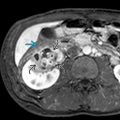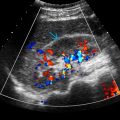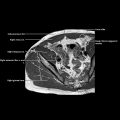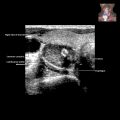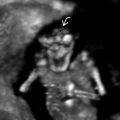KEY FACTS
Terminology
- •
Gartner duct cyst: Embryonic remnant of wolffian (mesonephric) duct, lined with nonmucinous columnar cells
- ○
Associated with renal/ureteral/müllerian anomalies
- ○
Imaging
- •
Ultrasound is modality of choice
- •
Well-defined cyst with thin walls, may contain septa
- •
Anechoic to hypoechoic with increased through transmission
- •
Separate from cervix, in anterolateral vaginal wall
- •
Infection or hemorrhage → increased echogenicity of fluid
- •
Rarely, large enough to cause urethral obstruction
- •
Cyst may be seen posterior to bladder or protrude into bladder, mimicking ureterocele or urethral diverticulum
- •
MR provides better resolution and spatial differentiation from other organs
- ○
Usually low T1 signal intensity and high T2 signal intensity
- –
Hemorrhage or proteinaceous debris results in high T1 and T2 signal intensity
- –
- ○
- •
No internal flow on Doppler
- ○
Helps to confirm cystic nature rather than solid mass, such as vaginal tumor
- ○
Top Differential Diagnoses
- •
Nabothian cysts
- •
Vaginal inclusion cysts
- •
Urethral diverticulum
- •
Ectopic ureterocele
- •
Endometriosis
- •
If solid-appearing, consider vaginal tumors or cervical/vaginal polyp
Pathology
- •
Associations
- ○
Müllerian duct anomalies
- –
Unicornuate, bicornuate, didelphys, or septate uterus
- –
- ○
Renal anomalies
- –
Ipsilateral renal dysgenesis/agenesis
- –
Cross-fused ectopia/ectopic ureter
- –
- ○
Diverticulosis of fallopian tubes (salpingitis isthmica nodosa)
- ○
Clinical Issues
- •
Occurs in 1-2% of women; usually asymptomatic
- •
Incidental finding on imaging or pelvic examination
- •
Symptomatic if large: Pelvic pressure symptoms, dyspareunia, obstructed labor
- •
Infection/hemorrhage may cause acute pain
- •
May present with urologic symptoms
Diagnostic Checklist
- •
In females with ipsilateral renal dysgenesis, ureterocele-like “cyst” without associated ureteric dilatation is highly suspicious for Gartner duct cyst
Scanning Tips
- •
Partial withdrawal of transvaginal probe or light pressure helpful to minimize cyst compression
- •
Transperineal sonography can be alternative
 inferior to the cervix
inferior to the cervix  . The endometrium
. The endometrium  is normal in this retroverted uterus.
is normal in this retroverted uterus.
 in the upper vagina, consistent with Gartner duct cysts.
in the upper vagina, consistent with Gartner duct cysts.
 , inferior to the cervix
, inferior to the cervix  , which contains a nabothian follicle
, which contains a nabothian follicle  .
.
Stay updated, free articles. Join our Telegram channel

Full access? Get Clinical Tree




